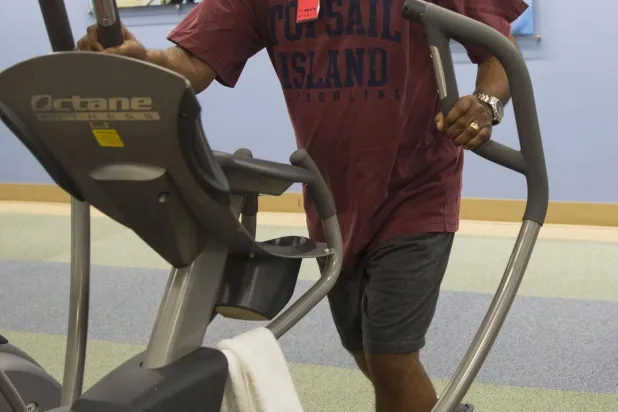
Exercise plays an effective role in rehabilitating patients with many diseases, and in many of these cases hastened the pace of treatment and increases its efficiency. Chronic diseases can be thrown in heavy shadows on the lives of patients. Now, the rehabilitation based on exercise is a qualitative shift as a radical change factor.
In the following points, we review how exercise contributes to reducing the risk of 5 diseases.
1 – Atrial fibrillation
An analysis of data collected for a number of research, conducted by a team of researchers led by the University of Liverpool, and published in the British Journal of Sports Medicine, showed that cardiovascular rehabilitation reduces the severity and repetition of the most common form of heart rhythm disorder, which is the atrial fibrillation (AF). The general ability to exercise and mental health also improve, without causing any serious side effects.
According to a press release, on Tuesday, atrial fibrillation occurs when the upper heart rooms (atria) do not properly contract, but rather rising, disrupting the electrical signals to the lower rooms (Al -Bateen). Symptoms can include heart palpitations, chest pain, fatigue, dizziness, and shortness of breath. Atrial fibrillation is associated with an increased risk of stroke and heart failure.
The results of the results of the results showed that this type of rehabilitation reduced the severity of the symptoms by 39 percent, the repetition and duration of atrial fibrillation attacks by 43 percent, and the risk of its repetition by 32 percent.
It also significantly improved the ability to exercise, and the effects were consistent, regardless of the type of atrial fibrillation, the rehabilitation dose, the patient’s properties, or the method of providing treatment.
The researchers say: “Exercise training is positively reshaping the atrium, including reducing atrium sclerosis and fibrosis, which may help reduce the compromised conditions of atrial fibrillation, despite the need for further research,” the researchers say.
They add: «It is known that exercise training has psychological benefits, including reducing anxiety and depression, which are common for individuals with atrial fibrillation, and can be exacerbated by the perception of symptoms.
2 – Chronic kidney disease
On the other hand, a study published, September 2023, showed in the journal “Karen Obinnin in Niferology and Hiebernechin”. Exercise -based rehabilitation can slow chronic kidney disease, promote preparation for cultivation and recovery, and improve the quality of life.
Researchers at the University of Bronil, London and the Kings College Hospital Foundation, of the National Health Services Authority, analyzed recent modern evidence about the effect of exercise on the health of people with kidney disease.
“There is now a set of kidney guidelines and guidelines that support the power of launching practical and developed practical interventions based on exercise for people with chronic kidney disease,” said Dr. Charlene Greenwood, a physiotherapy consultant at Kings College Hospital.
Self -management interventions that focus on physical activity are gaining an increased momentum in caring for chronic kidney patients, which requires early application.
According to the results of the study, the preparation for kidney transplant surgery and recovery, after which two basic phases in which exercise -based rehabilitation, such as walking, swimming and cycling can be caused by a vital difference for chronic kidney patients.
3- Breast cancer
Exercise and rehabilitation can be merged in breast cancer care, according to a clinical experiment whose results were published in the journal “Kansir”, starting with the diagnosis and throughout the care period. Participants have shown positive opinions on the program, supporting the efforts made to integrate exercise and rehabilitation services as part of routine care for cancer patients.
The results stated that rehabilitation services deal with nervous and musculoskeletal imbalances, such as poor shoulder movement and peripheral nerve injury. According to the patient’s stage in the cancer care program, it may need both service
The association with exercise and rehabilitation services greatly helped treat their symptoms after treating cancer. They also stated that exercise and rehabilitation services throughout their sponsorship had a positive impact on their participation in physical activity and their physical functions.
4 – Multiple sclerosis
A team of experts in multiple sclerosis research recommends that an organized approach to studying sports training mechanisms to improve the results of multiple sclerosis patients.
In an review article published in the Journal of Multiple Sclerosis and Related Disorders, on April 16, 2024, the researchers stressed the importance of adopting a experimental medical framework to improve the development, evaluation and application of exercise interventions in the rehabilitation of multiple sclerosis patients.
Multiple sclerosis is a chronic disease, often causes disability, affects the central nervous system, weakens motor and cognitive functions, and affects millions of individuals around the world. Despite the effectiveness of drug treatments in preventing multiple sclerosis setbacks, they are not designed to improve jobs that are negatively affected by the disease.
As the main researcher, Dr. Brian Sandrov, Assistant Director of the Center for Neuroscience and Neurology Research at the Kisler Foundation, and the director of the Center for Neurological Rehabilitation Research in the Center: “By understanding how exercise affects the functions of the central nervous system in multiple nervous sclerosis, we can design and improve interventions that improve movement, perception and quality of life.”
5 – People with knee joint infection
Natural therapy for knee joint inflammation is usually more assigned to patients, and it has much greater trouble than a fast steroid injection to relieve joint pain.
But in the long run, physical therapy is at least effective, such as steroid injection, and is likely to provide longer comfort, according to a new study. “Although the initial costs of physiotherapy may be slightly higher throughout the year, when looking at all the costs related to the knee throughout the year, the amount of interest I obtained from physical therapy made it more costly effective,” said the main researcher Daniel Ron, director of the Entippine Entrepreneurial Musical Care Center and the Entipide Clinical Center at Brock Military Medical Center in San Antonio.
Ron added that people with knee joint inflammation usually have two main options for treatment outside surgery, either obtaining a steroid injection to relieve swelling and pain, or undergo a round of physical therapy and sports rehabilitation. “When you undergo effective intervention, such as exercise, its effects last longer because it strengthens your knee, which increases its ability to perform its functions.” He added: “The injection does not change your knee strength, and as soon as the pain disappears, your knee will not necessarily work better if you do not stop it.”



